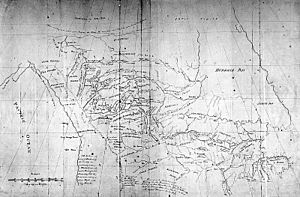Peter Pond facts for kids
Quick facts for kids
Peter Pond
|
|
|---|---|
| Born | January 18, 1739 |
| Died | 1807 (aged 68) |
| Nationality | British (1739-1776) and American (1776-his death) |
| Occupation | Soldier, fur trader, explorer and a cartographer |
Peter Pond (born January 18, 1739 or 1740 – died 1807) was an important explorer, fur trader, and mapmaker. He was also a soldier during the French and Indian War. Peter Pond helped create the North West Company and the Beaver Club. Although he was born and died in Milford, Connecticut, he spent most of his life exploring and trading furs in northwestern North America.
Contents
Peter Pond's Early Life and Fur Trading

Peter Pond started his fur trading business with his father. They worked out of Fort Detroit. He traded furs in areas that are now Minnesota and Wisconsin. These regions are located south of Lake Superior and west of Lake Michigan.
Through his work, Peter Pond met other important fur traders. These included Alexander Henry the elder, Simon McTavish, and the Frobisher brothers (Thomas, Benjamin, and Joseph). Together, they formed the North West Company (NWC). This company became a strong rival to the Hudson's Bay Company (HBC).
Exploring New Fur Lands
Peter Pond explored west of the Great Lakes to find new places for fur trading. From 1776 to 1778, he spent the winter at a fur trading post he built. This post was located where the Sturgeon River meets the North Saskatchewan River. This area is close to what is now Prince Albert, Saskatchewan. Today, this site is a National Historic Site.
At Lac La Ronge, another fur trader named Jean-Étienne Waddens had a successful business. He traded with Indigenous peoples from the Lake Athabasca area. In late 1781, Peter Pond joined Waddens. They both worked for the North West Company. However, they did not get along well. In March 1782, Waddens was badly hurt in a fight and later died.
In 1783, Waddens' wife asked the Governor of Quebec, Frederick Haldimand, to look into the matter. Peter Pond was questioned in 1785. However, he was not put on trial. This was likely because Lac La Ronge was in the Hudson's Bay Company's territory. This meant it was outside the legal area of the Province of Quebec.
Mapping the Athabasca Region
In 1783, Peter Pond's explorations led him to the District of Athabasca. This large region stretches from Lac Île-à-la-Crosse to the Peace River. He explored the waterways around Lake Athabasca. He also learned about the locations of Great Slave Lake and Great Bear Lake. He got this information from the First Nations peoples living in the area.
Using his notes and diaries, Peter Pond drew a map. This map showed the rivers and lakes of the Athabasca region. It also included what was known about the entire area from Hudson Bay to the Rocky Mountains. He even guessed where the rivers might flow towards the Arctic Ocean or the Northwest Passage.
Sharing His Maps
In 1785, Peter Pond sent a copy of his map and a detailed report to the United States Congress. He sent another copy to the Lieutenant Governor of Quebec, Henry Hamilton. Pond hoped to get money to continue his explorations further into North America's northwest. However, the British government did not provide the funding.
Peter Pond was a partner in the North West Company, which was founded in 1784. He was in charge of the company's business in the Athabasca and Peace River areas. Pond was known for being ambitious and having a quick temper. He was involved in two incidents where people died. Even though he was not found guilty, the company replaced him with Alexander Mackenzie.
As Mackenzie took over the business, he learned a lot from Peter Pond. Pond shared his knowledge about the Athabasca and Peace River regions. Peter Pond left the North West Company in 1788.
Peter Pond's Legacy
Alexander Mackenzie was very interested in Peter Pond's ideas. Pond believed that the rivers in the Athabasca area flowed into a large river that went northwest. He thought this river might lead to the Northwest Passage. Mackenzie decided to follow up on Pond's idea. He explored this great river all the way to its end. This river, now called the Mackenzie River, does indeed flow to the Arctic Ocean, which is part of the Northwest Passage.
Peter Pond helped map Canada by drawing the general shape of the river basin that Mackenzie explored in 1789. The maps Peter Pond drew, based on his own explorations and information from First Nations peoples, became well-known around the world by the end of the 1700s.
In 1790, Peter Pond sold his shares in the North West Company to William McGillivray. He then returned to Milford, Connecticut, where he passed away in 1807.
See also
 In Spanish: Peter Pond para niños
In Spanish: Peter Pond para niños

